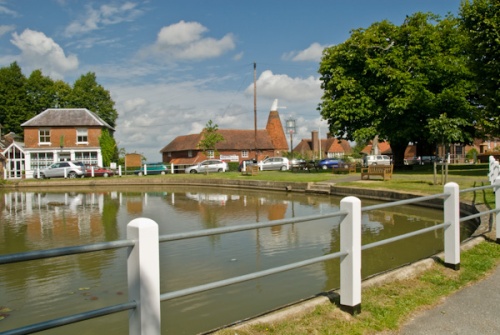
Goudhurst is a pretty village in the Kentish Weald, about 12 miles south of Maidstone. The village is absurdly picturesque, with a timber-framed inn standing beside the 12th-century church and traditional oast houses looking over the village duck pond. Climb the 150ft high church tower for superb views over the Weald.
There are a remarkable 217 listed buildings in Goudhurst, including five oast houses. The historic high street has changed very little over the centuries and features a lovely collection of historic buildings, many of then in traditional Kentish weatherboard style.
History
The village name comes from a combination of 'goud' and 'hurst'. The latter means a wood, but the meaning of 'goud' is obscure; it may simply refer to a woodland clearing. The woodland in question was the Anderida, a huge forest that once covered most of south-east England.
St Mary's Church
The first mention of Goudhurst comes in 1095 when the settlement here was called Guithhyrste. Sometime around 1119, a chapel was erected on the top of the hill in Goudhurst. That chapel grew to become St Mary's Church. The church's location made it a perfect spot for a lookout during both World Wars. You can climb to the top of the tower, where on a clear day it is said you can see 51 churches and even spot the Canary Wharf Tower in London.
Historical highlights include memorials to generations of the Culpepper family. The best memorial is that of Sir Alexander Culpepper and his wife, installed in 1537. This is one of just 80 surviving wooden effigy tombs in Britain.

Goudhurst was a centre of the Wealden iron trade from the 15th century and had a thriving weaving industry. It was also at the centre of a hop-growing region. Opposite the churchyard is a row of old weavers' cottages. Flemish weavers came to Kent around 1330, and the cottages were built about 20 years later in 1350. Weavers based here became wealthy by weaving broadcloth.
The Flemish weavers brought more than weaving skills to Goudhurst; they brought a taste for beer brewed with hops and a knowledge of how to brew it. They started planting small hop gardens and within a few generations, the Weald was covered in hop farms. For hundreds of years, hop-picking was an annual event, with workers from London descending on Goudhurst each year to pick hops.
During the Tudor period, the Kentish Weald was known as the 'black country' for its thriving iron mining industry. Sir Alexander Culpepper's forge at nearby Bedgebury cast the cannon used to fight the Spanish Armada.

The Battle of Goudhurst
By the 18th century, the iron industry had died, and this area of Kent was a centre for smuggling. The infamous Hawkhurst Gang ruled the Goudhurst area under the leadership of George Kingsmill, a native o Goudhurst. The residents of Goudhurst decided to fight back against the Hawkhurst Gang's reign of terror and formed a militia under William Sturt.
Kingsmill swore to defeat the militia, and the gang marched on the town. Women and children took refuge in the church, and in a battle that raged through the churchyard and the neighbouring Star and Eagle pub, three smugglers including Kingsmill's brother George were killed and others of the gang were captured and imprisoned in the church vestry.
Kingsmill was eventually captured and executed at Tyburn in London, but his body was brought back to Goudhurst where it was hung in chains. The 'Battle of Goudhurst' broke the power of the Hawkhurst Gang forever.
Finchcocks
Just outside Goudhurst is Finchcocks, a Georgian mansion famous for its collection of historic musical instruments. The collection includes more than 100 keyboards, and over 40 of them are in working order. The house is usually closed but there are piano courses available, using historic keyboard instruments.

Scotney Castle
Just over a mile away is Scotney Castle, a 14th-century moated castle in a wooded valley location. The medieval castle was incorporated into a Tudor manor house with a secret chamber for hiding Catholic priests. Looking down on the moated site is a Victorian mansion designed by the architect Anthony Salvin for the Hussey family. The mansion and castle stand in over 700 acres of glorious woodland and hillside gardens.
Getting There
Goudhurst is at the junction of the A262 and the B2079 between Lamberhurst and Cranbrook. There is free parking behind the duck pond off Balcomes Hill (the B2079 south of the village crossroads).
About Goudhurst
Address: Goudhurst,
Kent,
England
Attraction Type: Town
Location: Goudhurst is 10 miles east of Tunbridge Wells and 14 miles south of Maidstone.
Location map
OS: TQ722 377
Photo Credit: David Ross and Britain Express
HERITAGE
 We've 'tagged' this attraction information to help you find related historic attractions and learn more about major time periods mentioned.
We've 'tagged' this attraction information to help you find related historic attractions and learn more about major time periods mentioned.
Historic Time Periods:
Find other attractions tagged with:
14th century (Time Period) - Henry V (Person) - Medieval (Time Period) - Spanish Armada (Historical Reference) - Tudor (Time Period) -
NEARBY HISTORIC ATTRACTIONS
Heritage Rated from 1- 5 (low to exceptional) on historic interest
Goudhurst, St Mary - 0 miles (Historic Church) ![]()
Finchcocks - 1.5 miles (Museum) ![]()
Bedgebury National Pinetum - 2.5 miles (Garden) ![]()
Scotney Castle - 2.6 miles (Castle) ![]()
Cranbrook Museum - 3.5 miles (Museum) ![]()
Bewl Water - 3.6 miles (Countryside) ![]()
Bayham Abbey - 4.6 miles (Abbey) ![]()
Sissinghurst Castle Garden - 5 miles (Garden) ![]()
Nearest Holiday Cottages to Goudhurst:
Tunbridge Wells, Kent
Sleeps: 4
Stay from: £380 - 1162
More self catering near Goudhurst









